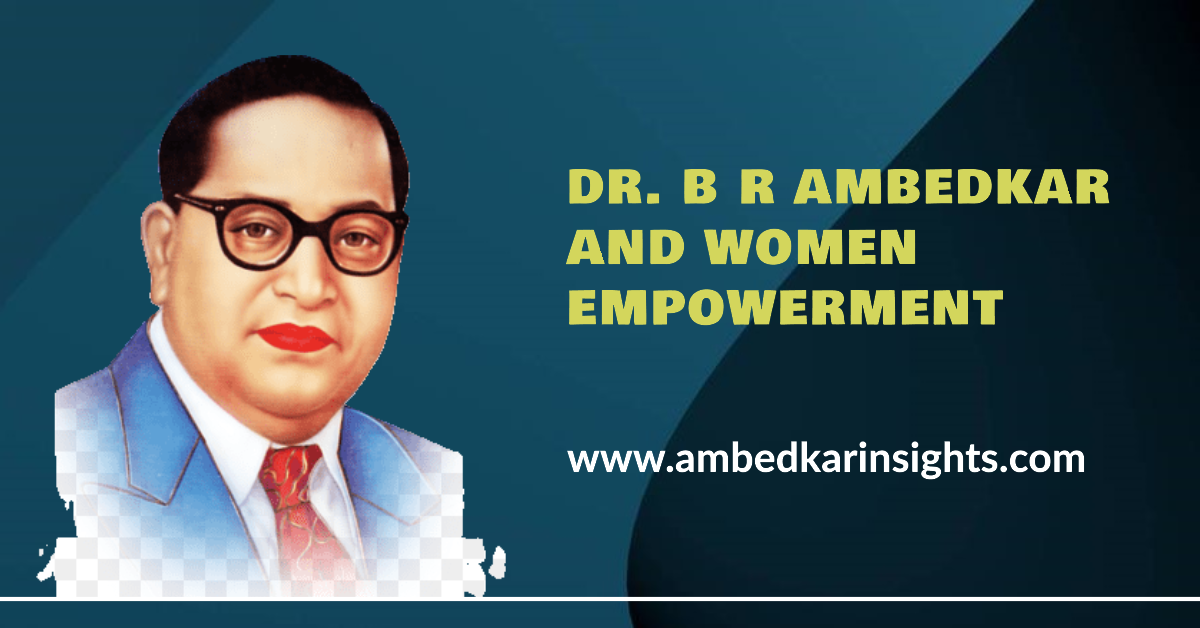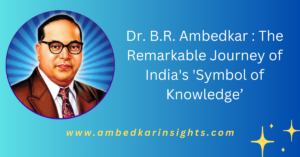|
Getting your Trinity Audio player ready...
|
“B R Ambedkar and Women Empowerment” stands as a testament to Dr. Bhim Rao Ambedkar’s luminary role in Indian history, particularly his championing of women’s rights and upliftment alongside his seminal work for marginalized communities. His visionary approach, which spanned areas like education, economic autonomy, and legal reforms, has solidified his reputation as a pioneering feminist thinker. With contemporary India navigating a complex landscape of gender challenges, Ambedkar’s doctrines offer enduring inspiration, shaping the nation’s feminist narrative. This article explores the profound influence and contemporary relevance of his contributions to women’s rights.
Introduction:
“B R Ambedkar and Women Empowerment” is a central theme reflecting Dr. Bhim Rao Ambedkar’s profound legacy. Popularly known as Baba Saheb Ambedkar, he is a monumental figure in Indian history, celebrated for his diverse contributions. His role as a jurist was instrumental in shaping many of India’s foundational laws. As a social reformer, he was relentless in advocating for the marginalized, especially the Dalits, taking on the entrenched caste system. His political insights were foundational in creating policies for a just society. Amongst the spectrum of his work, his fervent advocacy for women’s rights stands out. He envisioned a society free from patriarchal constraints, emphasized women’s education, and was adamant about ensuring their legal rights, firmly positioning him as an early and visionary feminist thinker.
Ideas Regarding Women Upliftment:
During his era, Dr. Bhim Rao Ambedkar introduced radical and transformative ideas, especially concerning women’s rights. He was convinced that for women to truly rise in society, it would require more than just laws. The very fabric of societal thinking had to undergo a metamorphosis. Here’s a closer look at his primary beliefs:
1. Education as Liberation:
– Breaking Chains: In a society where women were often limited by traditional norms, Ambedkar saw education as the means to break free. Think of education as the wings that could allow women to soar above these societal confines.
– Influence and Power: An educated woman, according to Ambedkar, wasn’t just beneficial for herself. She had the power to bring about positive changes in her community and society at large. Just as a single candle can light up a dark room, an educated woman could illuminate her surroundings with wisdom and understanding.
2. Financial Freedom:
– Dignity and Independence: Ambedkar believed money wasn’t just currency; it represented choice and freedom. A woman with economic independence wasn’t bound by financial constraints and could make decisions for her well-being and that of her family.
– Empowerment: Economic independence for women meant more than just having money. It signified self-respect, autonomy, and the power to shape one’s destiny.
3. Levelling the Social Playing Field:
– Challenging Hierarchies: The Indian society of Ambedkar’s time was like a ladder, with some groups always kept at the bottom. Women often found themselves in these lower rungs. Ambedkar, however, didn’t believe in this ladder system. He envisioned a society where everyone stood on the same level ground.
– An Equal Stake: Imagine a table where all the major decisions of society are made. Ambedkar wanted women to have an equal seat at the table, having an equal voice in shaping the society they lived in.
4. The Right to Legal Equality:
– A Bold Blueprint: Ambedkar drafted the Hindu Code Bill, a set of laws that would give women equal rights in matters like property ownership, marriage choices, and the ability to divorce. This was his vision for a society where women’s rights were legally protected.
– Facing Opposition: While this vision was progressive and necessary, it wasn’t universally welcomed. Many opposed these changes, fearing a disruption of age-old customs. However, the very fact that these ideas were discussed and debated was a testament to Ambedkar’s revolutionary approach.
In essence, Dr. Ambedkar’s ideas on women’s upliftment were a blend of socio-cultural change and legal reforms. He realized that for women to truly achieve equality, both society’s mindset and the legal framework had to evolve simultaneously.
Movement and Work Done by Ambedkar:
Dr. Ambedkar’s advocacy for women’s rights was evident in his multifaceted approach. Politically, he spearheaded legislative reforms aimed at gender equality. On the social front, he emphasized the importance of education and empowerment as catalysts for change. Collectively, these endeavours underscored his profound commitment to advancing women’s stature in society.
Hindu Code Bill: A Pioneering Legislative Endeavor
The Hindu Code Bill, spearheaded by Dr. Bhim Rao Ambedkar, stands as a testament to his visionary approach towards legal reforms in post-independence India. This ambitious legislative proposition sought to comprehensively overhaul Hindu personal laws, many of which were entrenched in antiquated traditions and norms.
Key Provisions:
1. Equal Property Rights: The bill endeavoured to level the playing field by granting women rights equivalent to men in matters of inheritance and property ownership. This was a ground-breaking move, given the patriarchal biases deeply ingrained in customary practices.
2. Right to Divorce: At a time when marital dissolution was stigmatized and almost entirely skewed against women, the bill proposed to recognize the right of women to seek a divorce, thereby providing an avenue for them to extricate themselves from oppressive marital ties.
3. Eradication of Polygamy: Polygamy, though not ubiquitous, was permitted under certain traditional norms. The Hindu Code Bill sought to abolish this practice, emphasizing the sanctity and exclusivity of the marital bond.
4. Combatting Child Marriage: Recognizing the myriad socio-economic and health issues arising from child marriages, the bill aimed to outlaw this deep-rooted practice, advocating for the protection and well-being of minors.
Challenges and Legacy:
Despite its transformative potential, the Hindu Code Bill faced vehement opposition from conservative factions and traditionalists who viewed it as an affront to established customs. The intensity of the resistance was such that the bill could not be passed in its comprehensive form during Ambedkar’s tenure. However, its profound implications were not lost on subsequent lawmakers. The essence of the bill, though diluted, fragmented, and spread across different legislative acts, eventually found its way into Indian legal statutes, addressing issues of marriage, succession, and adoption.
In retrospect, the Hindu Code Bill’s legacy is not just in the laws it directly or indirectly influenced but also in the broader discourse it initiated on gender justice and legal reforms in a newly independent nation navigating the challenges of modernity while grappling with age-old customs.
Constitutional Safeguards: Dr. Ambedkar’s Vision for Gender Equality
In the annals of Indian history, Dr. Bhim Rao Ambedkar’s role as the chief architect of the Constitution is celebrated not just for its meticulous design but also for its foresight in championing rights for marginalized groups, notably women. As India emerged from the shadows of colonial rule and sought to lay the foundation for its democratic ethos, Ambedkar envisioned a Constitution that would be an instrument of social justice, and gender equality was an integral part of this vision.
1. Equal Rights Under the Law:
At the very outset, in the Preamble itself, the Constitution promises to secure for all its citizens justice – social, economic, and political. Dr. Ambedkar, with his profound understanding of societal inequities, made sure that the document he helmed did not remain gender-blind. Article 14 of the Constitution, which ensures “equality before the law,” serves as a clear testament to this, as it guarantees that every individual, irrespective of their gender, will be treated equally in the eyes of the law.
2. Protection from Discrimination:
Ambedkar’s insight into societal prejudices, particularly those based on caste and gender, led to the incorporation of Article 15. This article categorically prohibits discrimination on various grounds, including gender. It embodies the principle that no woman should face a disadvantage merely because of her gender. In fact, it goes a step further, allowing for affirmative actions in favour of women to redress historical injustices.
3. Equal Opportunities in Employment:
The challenge of gender equality is not just about protection but also empowerment. Article 16, under the guiding hand of Ambedkar, promises equality of opportunity in matters of public employment. It ensures that no citizen will be discriminated against in employment opportunities because of their gender. This provision underscores the belief that women should stand shoulder-to-shoulder with men in every sphere, including the professional realm.
The Legacy:
The Indian Constitution, thanks to Dr. Ambedkar’s visionary leadership, became one of the earliest to emphasize gender equality so prominently. While the journey towards achieving complete gender justice is ongoing, the constitutional provisions laid down under Ambedkar’s guidance provide a robust framework to challenge and rectify gender-based inequities. They serve as a constant reminder of the nation’s commitment to ensuring that half of its population isn’t left behind simply because of their gender.
Women’s Associations and Dr. Ambedkar’s Advocacy:
Dr. Ambedkar, recognizing the collective strength in unity, championed the establishment of women’s associations and unions. These platforms empowered women to articulate their grievances and collectively demand their rightful place in society. During the 1920s, his commitment was further manifested when he orchestrated women’s conferences. These weren’t mere gatherings; they were forums where progressive ideas like family planning and women’s education took centre stage. Additionally, he used these conferences as platforms to vehemently oppose regressive practices like Sati and child marriage, highlighting his holistic approach towards women’s empowerment and rights.
Challenging Deep-rooted Customs: Dr. Ambedkar’s Stance on Traditional Malpractices:
In a society deeply entwined with age-old traditions and customs, Dr. Bhim Rao Ambedkar emerged as a vociferous critic of practices that demeaned and endangered women. His unequivocal denunciation of the ritual of Sati, where a widow was expected to self-immolate on her husband’s pyre, challenged its very roots and questioned its place in a modern, evolving society.
Moreover, Ambedkar’s opposition to child marriages was not merely a stand against an early marital bond, but a statement against robbing childhood innocence and subjecting young girls to the rigours of early motherhood and marital responsibilities.
His concerns also extended to the marginalized widows, who, shunned by society and often relegated to a life of penance and neglect, bore the brunt of societal prejudices. Ambedkar’s stance against their ill-treatment was a call for introspection, urging society to re-evaluate and reform its ingrained biases.
By publicly opposing these entrenched practices, Dr. Ambedkar not only underscored the urgency for reforms but also facilitated a wider conversation, pushing society to rethink and recalibrate its stance on gender justice and equality.
Enduring Relevance of Dr. Ambedkar’s Vision on Women’s Upliftment:
As societies evolve and challenges morph, the foundational principles espoused by luminaries like Dr. Bhim Rao Ambedkar acquire even greater resonance. His perspectives on women’s rights and emancipation, steeped in both foresight and deep understanding of societal structures, remain relevant in contemporary times for several reasons:
1. Architect of Women’s Rights:
Dr. Ambedkar’s rigorous advocacy in the early days of India’s republic provided the cornerstone for women’s rights in the country. He envisioned an India where women weren’t just passive beneficiaries but active stakeholders. Today’s feminists, advocating for varied issues, find their roots in the principles he championed, especially his stress on education as an empowerment tool and economic autonomy as a means for women to assert their agency.
2. Legal Pillars for Gender Justice:
Ambedkar’s contributions to the Constitution weren’t limited to broad principles. He ensured the inclusion of specific provisions safeguarding women’s rights, making the Indian Constitution a robust instrument for gender justice. These legal provisions, anchored in Ambedkar’s vision, empower women to seek redress against discrimination and injustice.
3. Alignment with Global Feminist Thought:
The 21st century has witnessed a burgeoning of feminist movements worldwide, emphasizing the interconnectedness of various forms of discrimination. Dr. Ambedkar’s ideas, which delved deep into the interplay of caste, class, and gender, are strikingly in tune with contemporary intersectional feminist theories. His work offers a nuanced framework, especially relevant in the Indian context, to understand these layered complexities.
4. Catalyst for Current Movements:
The ripple effects of Dr. Ambedkar’s philosophies can be observed in the myriad feminist movements across India today. From campaigns for equal representation to movements against caste-based discrimination, his ideals continue to fuel and inspire. Especially notable is his influence on Dalit feminism, which straddles the dual axes of caste and gender, drawing deeply from Ambedkar’s teachings.
In conclusion, while Dr. Ambedkar’s ideas were formulated in the context of a newly independent India, their universality and depth ensure that they remain not just relevant but central to discussions on women’s rights and gender justice today.


